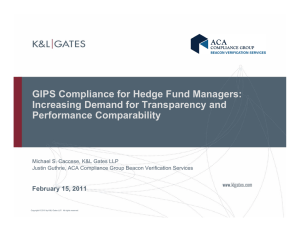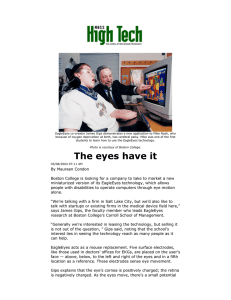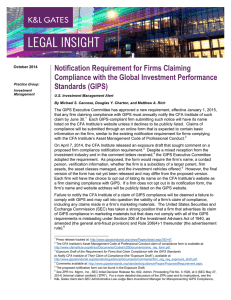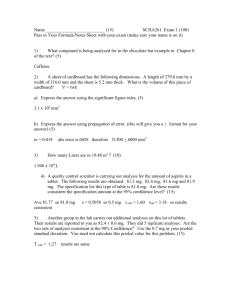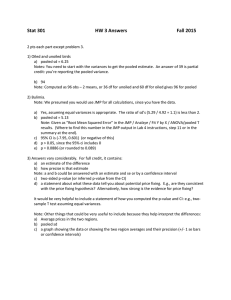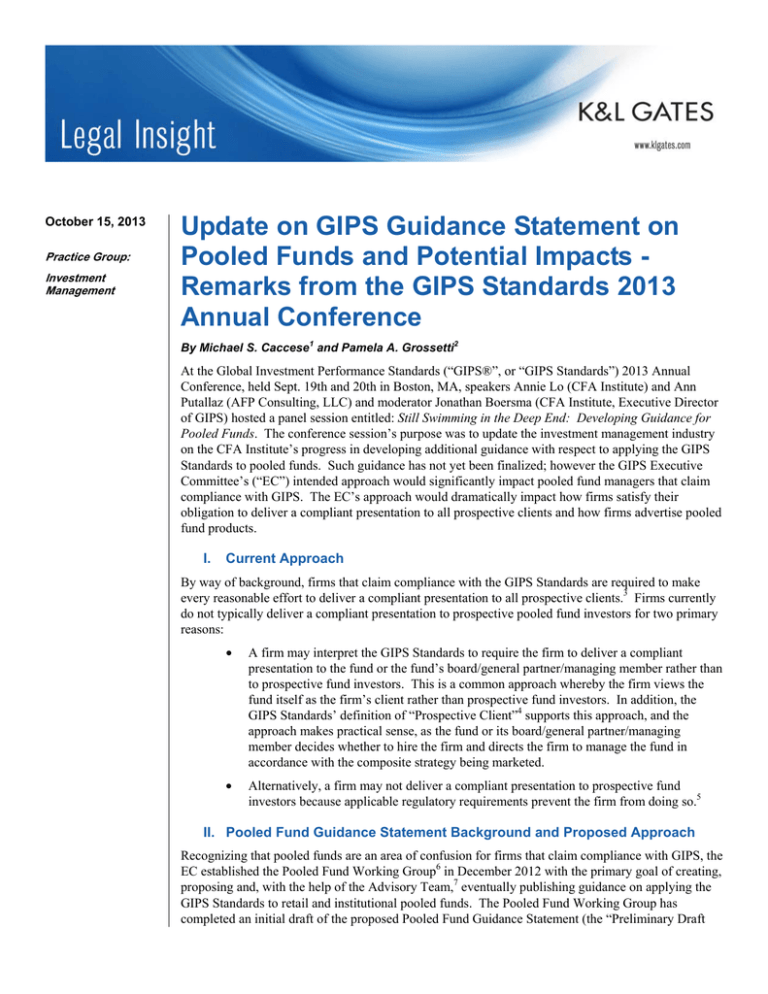
October 15, 2013
Practice Group:
Investment
Management
Update on GIPS Guidance Statement on
Pooled Funds and Potential Impacts Remarks from the GIPS Standards 2013
Annual Conference
By Michael S. Caccese1 and Pamela A. Grossetti2
At the Global Investment Performance Standards (“GIPS®”, or “GIPS Standards”) 2013 Annual
Conference, held Sept. 19th and 20th in Boston, MA, speakers Annie Lo (CFA Institute) and Ann
Putallaz (AFP Consulting, LLC) and moderator Jonathan Boersma (CFA Institute, Executive Director
of GIPS) hosted a panel session entitled: Still Swimming in the Deep End: Developing Guidance for
Pooled Funds. The conference session’s purpose was to update the investment management industry
on the CFA Institute’s progress in developing additional guidance with respect to applying the GIPS
Standards to pooled funds. Such guidance has not yet been finalized; however the GIPS Executive
Committee’s (“EC”) intended approach would significantly impact pooled fund managers that claim
compliance with GIPS. The EC’s approach would dramatically impact how firms satisfy their
obligation to deliver a compliant presentation to all prospective clients and how firms advertise pooled
fund products.
I.
Current Approach
By way of background, firms that claim compliance with the GIPS Standards are required to make
every reasonable effort to deliver a compliant presentation to all prospective clients.3 Firms currently
do not typically deliver a compliant presentation to prospective pooled fund investors for two primary
reasons:
•
A firm may interpret the GIPS Standards to require the firm to deliver a compliant
presentation to the fund or the fund’s board/general partner/managing member rather than
to prospective fund investors. This is a common approach whereby the firm views the
fund itself as the firm’s client rather than prospective fund investors. In addition, the
GIPS Standards’ definition of “Prospective Client”4 supports this approach, and the
approach makes practical sense, as the fund or its board/general partner/managing
member decides whether to hire the firm and directs the firm to manage the fund in
accordance with the composite strategy being marketed.
•
Alternatively, a firm may not deliver a compliant presentation to prospective fund
investors because applicable regulatory requirements prevent the firm from doing so.5
II. Pooled Fund Guidance Statement Background and Proposed Approach
Recognizing that pooled funds are an area of confusion for firms that claim compliance with GIPS, the
EC established the Pooled Fund Working Group6 in December 2012 with the primary goal of creating,
proposing and, with the help of the Advisory Team,7 eventually publishing guidance on applying the
GIPS Standards to retail and institutional pooled funds. The Pooled Fund Working Group has
completed an initial draft of the proposed Pooled Fund Guidance Statement (the “Preliminary Draft
Update on GIPS Guidance Statement on Pooled Funds and
Potential Impacts - Remarks from the GIPS Standards 2013
Annual Conference
Guidance Statement”). While the Preliminary Draft Guidance Statement has not yet been published
for public comment, and many details and technical issues remain unresolved, the panel discussion
provided some insight into the ways that the Preliminary Guidance Statement intends to address some
of the problem areas encountered by firms when applying the GIPS Standards to pooled funds, which
is summarized below.
The Preliminary Draft Guidance Statement deems, for GIPS compliance purposes, prospective pooled
fund investors to be “prospective clients” of a firm. Recognizing that GIPS guidance for pooled funds
must allow for complexities such as applicable regulatory requirements, the Preliminary Draft
Guidance Statement provides an exception from the compliant presentation delivery requirement and
will permit firms managing pooled funds to either: (1) deliver a fully-compliant GIPS presentation to
all prospective pooled fund investors; or (2) follow the GIPS Advertising Guidelines. The GIPS
Advertising Guidelines require that all advertisements that include a claim of compliance with the
GIPS Standards disclose: the definition of the firm; how prospective clients can obtain a compliant
presentation and/or the firm’s list of composite descriptions; and a prescribed GIPS compliance
statement for advertisements. In addition, the GIPS Advertising Guidelines require a firm to disclose
the composite description, composite total returns calculated in accordance of one of three prescribed
methods, whether returns are gross or net-of-fees, benchmark description and total returns for the
benchmark, and currency used to express performance, but only if an advertisement includes both (1)
a claim of compliance with GIPS; and (2) performance information.
Currently, if an advertisement does not include a claim of GIPS compliance, the advertisement is not
subject to the GIPS Advertising Guidelines. Therefore, it appears that if a fund’s offering materials
and related marketing materials do not refer to GIPS and include performance data, a firm would not
8
be required to deliver a GIPS compliant presentation to prospective pooled fund investors. We
expect that the Pooled Fund Guidance Statement, when published, will clarify this point. The
Preliminary Draft Guidance Statement also requires firms to include information required by the GIPS
Advertising Guidelines in the fund’s official document (e.g., the offering memorandum, the
prospectus in the U.S. or KIID in the U.K.). If local law prohibits the fund’s official document from
including such performance information, however, the Preliminary Draft Guidance Statement requires
a firm to include such information in all other fund marketing materials prepared by the firm.
III. Impact of the Proposed Approach
While much remains uncertain, it is clear that the approach contemplated by the Preliminary Draft
Guidance Statement represents a substantial and fundamental departure from the current GIPS
Standards. This approach would require firms to treat individual prospective fund
investors/shareholders as the firms’ prospective clients. This is a significant departure from current
industry practice and raises concerns regarding whether information such as composite performance
and other composite strategies managed by the firm is relevant information for prospective fund
investors.
In addition, the Preliminary Draft Guidance Statement inserts the GIPS Standards front-and-center
into all pooled fund advertising materials and official fund documents (such as prospectuses) unless an
exception is available, though it is not clear to what extent this will be the case if such materials do not
include both a claim of compliance with GIPS and performance data. This would require firms to
significantly change how they market their pooled fund products and prepare official fund documents,
including promptly stickering pooled fund offering documents to include performance information
calculated in accordance with the GIPS Standards. In addition, firms would need significant
2
Update on GIPS Guidance Statement on Pooled Funds and
Potential Impacts - Remarks from the GIPS Standards 2013
Annual Conference
additional guidance regarding how to apply the GIPS Advertising Guidelines to their pooled funds, as
there are many practical complications to consider.
IV. Recommendations
A proposed Pooled Fund Guidance Statement may be released for public comment as early as the first
half of 2014; however, the proposed provisions and guidance could change substantially from the
Preliminary Draft Guidance Statement. Until more concrete guidance is issued, firms claiming
compliance with GIPS should continue applying their current approach with respect to pooled fund
products (either treating funds or fund boards/general partners/managing members as prospective
clients or determining that applicable regulations prohibit firms from delivering compliant
presentations to individual fund investors). If and when the proposed Pooled Fund Guidance
Statement is published for public comment, the industry should be prepared to be actively involved in
the comment period to help ensure that any final guidance is practical and clarifies as many
ambiguities as possible.
1
Michael S. Caccese, a partner with K&L Gates LLP, is one of the Practice Area Leaders of the firm’s
Financial Services Practice, which includes the Investment Management and Broker-Dealer Practice
Groups. Mr. Caccese focuses his practice in the areas of investment management, including mutual
funds, closed-end funds, private investment funds, hedge funds, and managed accounts, in addition to
advising on investment management and broker-dealer regulatory compliance. He works extensively
with investment firms on compliance issues, including all forms of GIPS and CFA Institute standards. He
was previously the General Counsel to the CFA Institute and was responsible for overseeing the
development of the AIMR-PPS, GIPS, and other standards governing the investment management
profession and investment firms. He can be reached at 617.261.3133 and michael.caccese@klgates.com.
2
Pamela A. Grossetti, an associate with K&L Gates LLP, is a member of the firm’s Financial Services
Practice. Ms. Grossetti practices in the area of investment management and securities law, and focuses on
advising investment advisers, registered and unregistered investment companies and other financial
service providers on all legal and regulatory aspects of their operations. Ms. Grossetti counsels clients on
various compliance issues including proxy voting policies and performance advertisement review for
investment advisers. Ms. Grossetti also assists in the formation of and the provision of ongoing advice to
domestic and offshore unregistered investment companies. She can be reached at 617.951.9194 and
pamela.grossetti@klgates.com.
The authors would also like to acknowledge the assistance of K&L Gates Associate Michael J. Rohr for his
contributions to this Alert.
3
See, GIPS Standard 0.A.9.
4
The GIPS Standards define “Prospective Client” as: “Any person or entity that has expressed interest in
one of the firm’s composite strategies and qualifies to invest in the composite. Existing clients may also
qualify as prospective clients for any strategy that is different from their current investment strategy.
Investment consultants and other third parties are included as prospective clients if they represent
investors that qualify as prospective clients.”
5
By way of background, communications that are distributed by a broker-dealer that is a member of the
Financial Industry Regulatory Authority (“FINRA”), such as communications regarding registered funds and
many private funds, are subject to FINRA’s communications rules and related guidance. Pursuant to
FINRA guidance, related performance information may only be presented in communications marketing
section 3(c)(7) funds where the member ensures that all recipients of such communications are “qualified
3
Update on GIPS Guidance Statement on Pooled Funds and
Potential Impacts - Remarks from the GIPS Standards 2013
Annual Conference
purchasers”. See, NASD Interpretive Letter to Davis Polk & Wardwell (Dec. 30, 2003). Composite/strategy
performance data included in a GIPS compliant presentation inherently constitutes related performance
(unless the fund being marketed is the only fund in the composite). Applicable law in other jurisdictions
may impose similar or conflicting requirements.
6
The Pooled Fund Working Group consists of 12 members from 9 countries. It has worked since
December 2012 on preliminary steps leading up to drafting a proposed Pooled Fund Guidance Statement.
7
The Advisory Team consists of 27 members from 10 countries. It has consulted with the Pooled Fund
Working Group during the initial drafting process and provided comments and insight on the initial draft
of the proposed Pooled Fund Guidance Statement.
8
In the authors’ view, it seems likely that the Pooled Fund Guidance Statement will not permit firms to
continue to “opt-out” of the GIPS Advertising Guidelines with respect to pooled fund offering documents
and marketing materials that do not include a claim of GIPS compliance. As a result, firms that do not
deliver a GIPS-compliant presentation to all prospective pooled fund investors would be required to
comply with the GIPS Advertising Guidelines with respect to pooled fund offering documents and
marketing materials and include performance calculated in accordance with the GIPS Advertising
Guidelines in such materials regardless of whether such materials include a claim of compliance with GIPS.
© 2013 K&L Gates LLP
This article is for information purposes and does not contain or convey legal advice. The information
herein should not be used or relied upon in regard to any particular facts or circumstances without first
consulting with a lawyer.
Anchorage Austin Beijing Berlin Boston Brisbane Brussels Charleston Charlotte Chicago Dallas Doha Dubai Fort Worth Frankfurt
Harrisburg Hong Kong Houston London Los Angeles Melbourne Miami Milan Moscow Newark New York Orange County Palo Alto Paris
Perth Pittsburgh Portland Raleigh Research Triangle Park San Diego San Francisco São Paulo Seattle Seoul Shanghai Singapore Spokane
Sydney Taipei Tokyo Warsaw Washington, D.C. Wilmington
K&L Gates practices out of 48 fully integrated offices located in the United States, Asia, Australia, Europe, the
Middle East and South America and represents leading global corporations, growth and middle-market companies,
capital markets participants and entrepreneurs in every major industry group as well as public sector entities,
educational institutions, philanthropic organizations and individuals. For more information about K&L Gates or its
locations, practices and registrations, visit www.klgates.com.
This publication is for informational purposes and does not contain or convey legal advice. The information herein should not be used or relied upon in
regard to any particular facts or circumstances without first consulting a lawyer.
©2013 K&L Gates LLP. All Rights Reserved.
4

